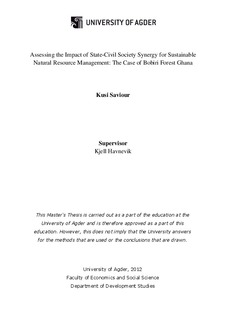| dc.contributor.author | Kusi, Saviour | |
| dc.date.accessioned | 2012-11-22T10:22:10Z | |
| dc.date.available | 2012-11-22T10:22:10Z | |
| dc.date.issued | 2012 | |
| dc.identifier.uri | http://hdl.handle.net/11250/135237 | |
| dc.description | Master thesis in development management- University of Agder, 2012 | no_NO |
| dc.description.abstract | The emphasis on fostering state-civil society synergy for improving human well-being and sustainable development has been recognized in development circles and especially in Third World countries. This recognition to some extent has its roots from the past failures of the state (governments) alone tackling and initiating affairs as a lead development agency to deliver the needed development through its institutions, agencies, sectors and departments (Bruce, 1994). Unfortunately such situations usually sideline the energies of the society needed to complement state efforts to promote good governance and improvement in human well-being.
Thus, the ‘synergy hypothesis’ has caused many state institutions in the world wide to pay increased attention to the efficacy of civil-society in participatory development. Evidently literature have shown that (see for example World Bank, 2004), to ensure sustainable development the de jury mandate authority structure (state) must be influenced by informal (society) power relations to ensure inclusion of varied energies. This is to augment and compensate for the limitations of the state if indeed governance for development is intended to truly benefit the collective good of society. This study responds to this ‘hypothesis’ by offering a theoretically informed empirical investigation directed towards the better understanding of the effects that synergy has had on local communities abilities to sustainably manage their natural resources.
The empirical investigation is based on a case study of Bobiri Forest and the strategies that FORIG (a state institution) has established to enhance collaborative management of the forest with communities of Kubease and Kroforom in the Ashanti Region of Ghana. DPSIR and State-Community Synergy conceptual frameworks were employed to assess responses from FORIG to mitigate drivers of forest degradation through efforts of complementarities and embeddedness with the communities. It was reveal that although many of the interventions in FORIG action plans seemed to be aligned to the most critical empirical drive needed for creating synergistic relations, the communities have not duly benefited from such interventions. This then highlights the importance of creating ‘soft’ institutional technologies to bridge the divide through synergistic relations for mutual gains. | no_NO |
| dc.language.iso | eng | no_NO |
| dc.publisher | Universitetet i Agder; University of Agder | no_NO |
| dc.subject.classification | UT 503 | |
| dc.title | Assessing the impact of state-civil society synergy for sustainable natural resource management: the case of Bobiri Forest Ghana | no_NO |
| dc.type | Master thesis | no_NO |
| dc.subject.nsi | VDP::Social science: 200::Social anthropology: 250 | no_NO |
| dc.source.pagenumber | 110 s. | no_NO |
